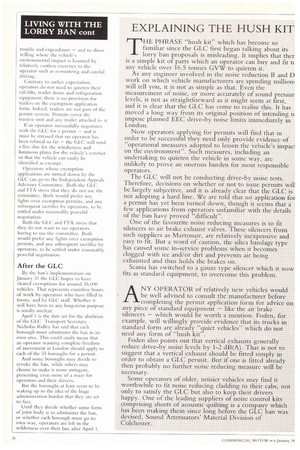EXPLAINING THE HUSH KIT
Page 26

If you've noticed an error in this article please click here to report it so we can fix it.
THE PHRASE "hush kit" which has become so familiar since the GLC first began talking about its lorry ban proposals is misleading. It implies that ther is a simple kit of parts which an operator can buy and fit tc any vehicle over 16.5 tonnes GVW to quieten it.
As any engineer involved in the noise reduction L. and .13 work on which vehicle manufacturers are spending million will tell you, it is not as simple as that. Even the measurement of noise, or more accurately of sound pressur levels, is not as straightforward as it might seem at first, and it is clear that the GLC has come to realise this. It has moved a long way from its original position of intending tc impose planned EEC drive-by noise limits immediately in London.
Now operators applying for permits will find that in order to be successful they need only provide evidence of operational measures adopted to lessen the vehicle's impac on the environment". Such measures, including an undertaking to quieten the vehicle in sonic way, are unlikely to prove an onerous burden for most responsible operators.
The GLC will not be conducting drive-by noise tests. Therefore, decisions on whether or not to issue permits will be largely subjective, and it is already clear that the GEC is not adopting a hard line. We are told that no application for a permit has yet been turned down,_ though it seems that a few applications from operators unfamiliar with the details of the ban have proved "difficult".
One of the favourite noise reducing measures is to fit silencers to air brake exhaust valves. These silencers from such suppliers as Martonair, are relatively inexpensive and easy to fit. But a word of caution, the silica bandage type has caused some in-service problems when it becomes clogged with ice and/or dirt and prevents air being exhausted and thus holds the brakes on.
Scania has switched to a gauze type silencer which it now fits as standard equipment, to overcome this problem.
ANY OPERATOR of relatively new vehicles would be well advised to consult the imanufacturer before . completing the permit application form for advice on any piece of standard equipment — like the air brake silencers — which would be worth a mention. Foden, for example, will willingly provide evidence that its trucks in standard form are already "via vehicles" which do not need any form of "hush kit' .
Foden also points out that vertical exhausts generally reduce drive-by noise levels by 1-2 dB(A). That is not to suggest that a vertical exhaust should be fitted simply in order to obtain a GLC permit. But if one is fitted already then probably no further noise reducing measure will be necessary.
Some operators of older, noisier vehicles may find it worthwhile to fit noise reducing cladding to their cabs, not only to satisfy the GLC but also to keep their drivers happy. One of the leading suppliers of noise control kits . comprising sheets of acoustic quilting is .a company which
has been making them since long before the GLC: ban Was , devised, Sound Attenuators' Material Division of Colchester.






















































